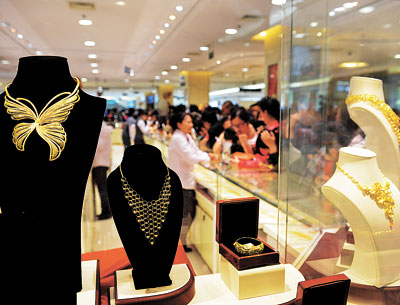|

Liu Minxia
mllmx@msn.com
A SURGE in demand for gold ornaments and coins after the biggest slump in prices in three decades boosted sales for Shenzhen’s gold jewelry makers, but limited production capacities and dwindling profit margins kept their earnings lower than initial sky’s-the-limit expectations.
Previous media reports said Chinese consumers bought 300 tons of physical gold within 10 days following a 4 percent plunge in gold prices April 12, the steepest fall since the 1980s. Prices of the yellow metal tumbled an additional 9 percent April 15.
As more than 70 percent of gold ornaments, bars and coins sold on the China market are produced by Shenzhen companies, according to government statistics, local jewelry makers were expected to have racked up huge profits in the past month.
“Sales surged indeed, but it’s not as good as presumed by outsiders,” said Li Weizhu, general manager of Zhou Liu Fu Jewelry, a leading Shenzhen jewelry maker located in the city’s key jewelry base of Shuibei. “There is a limit to production capacity, which means we couldn’t fulfill all the orders.”
Sales at Zhou Liu Fu’s 1,100 retail outlets nationwide doubled last month, Li said, but profit margins narrowed by 20 percent because the higher prices at which they bought gold prior to the sudden plunge ate into profits.
Liu Wei, spokesperson for Bofook Lilang Jewelry Culture Industry Zone, another major Shenzhen jewelry-making base in Longgang District, said Bofook recruited more than 100 workers in mid-April to speed up production, but many new workers couldn’t be sent to production lines right away because they weren’t skilled enough.
“Our existing team of workers had to work against the clock, and it was impossible for us to churn out enough gold items to fulfill all the orders,” Liu said. “Even now, we are still working on orders received last month.”
Batar Jewelry, a well-known jewelry brand in Shenzhen that sells about 100 tons of gold jewelry every year, saw an 80 percent growth in sales last month.
“Profit margins for jewelry makers have been dwindling due to rising costs of labor and operations,” said Xi Xiaoqing, an assistant to Batar’s president. “We earn less than 100 million yuan (US$16.1 million) for selling 8 billion yuan of jewelry every year. During this gold rush, we sold more but earned not as much. This is something we should reflect on.”
Gold ornament sales are no longer as swift as in April, but are still better than the same time in previous years, despite the fact that many insiders fear the consumption of gold ornaments may come to a halt as many consumers made purchases ahead of their plans.
“Our sales in May are expected to be 30 percent higher than usual,” Li said. “We expect sales to remain at this level for the rest of the year because the consumer base grew in April, when gold prices invited worldwide attention.”
Gold experts continue to see bleaker days ahead for the yellow metal, once considered a safe haven. Ric Deverall of Credit Suisse forecast the price of gold would further dip in 2013, to US$1,100, and plunge even more in the next five years, to US$1,000.
“There is an urge among Shenzhen’s jewelry makers to upgrade along the value chains and build their own brands,” said Zhang Wenyang, deputy head of Shenzhen Gold and Jewelry Association. “To maximize profits, even some leading jewelry brands in Shenzhen still manufacture products that are sold under designer names.”
|

